Charger Basen S2
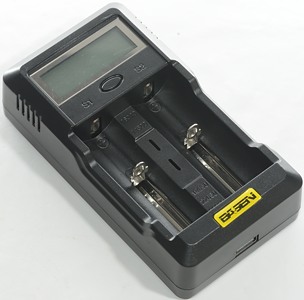
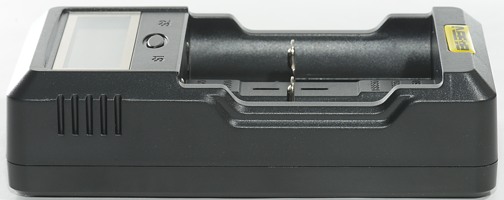
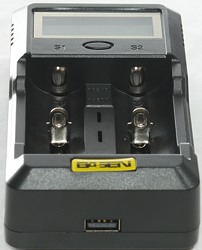
Basen sells LiIon batteries and this charger. The charger can handle both LiIon and NiMH batteries, includes a capacity measurement function and a usb power bank function. This sounds like a very useful unit, can it live up to it?

I got it without any box, only the charger and a US power supply.
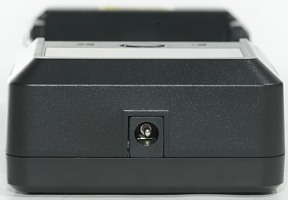
On the back the charger has a DC connector for 12 volt input, it can be used for the mains adapter or a car adapter.
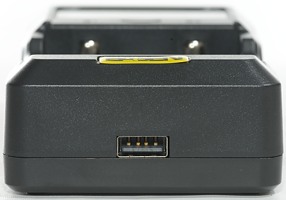
On the front is a usb connector for the usb power bank function.

The user interface is a single switch and a display.
A short press on the switch will change between 0.5A and 1A charge current.
A long press will enable the capacity measurement function, this discharge current will be 1/2 the charge current.
It is possible to toggle both functions during charge.
It is a very simple user interface and I like it, but I would have liked that the display stayed on while the charger was working.
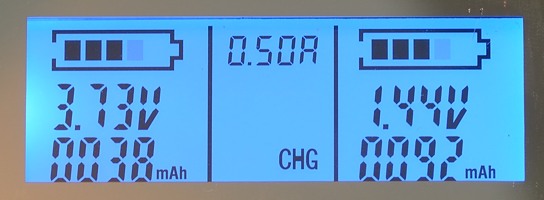
The display has a nice blue background light, but it is only on when pressing the button or putting batteries in the charger, then it turns off again.
Here the charge mode is selected with 0.5A charge current.
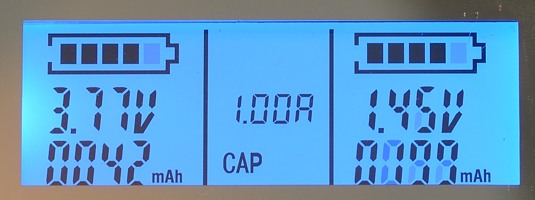
The blocks in the battery are animated and will show if the battery is charged or discharged.
Here the capacity mode is selected with 1A charge current and 0.5A discharge current.
The strange looking 199 is because I captured the display while the value was changing.
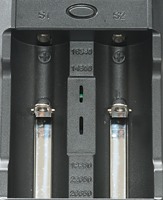
Between the two slots are listed some of the supported sizes, it would have been nice if it also listed chemistry or just AA/AAA/C (The label on the backside lists this).

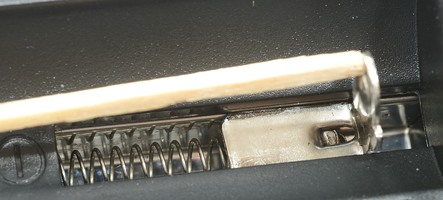
The charger has the usual battery slot construction, but something went wrong. They are difficult to slide back, I had to push them back with my finger, before I could put the battery into the slot (Usual I can use the battery to push the slider with).
The slots can accept batteries from 29mm to 69mm, this will give problems with some protected 18650 and 26650 batteries.





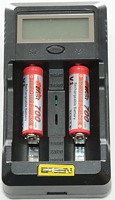
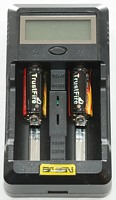
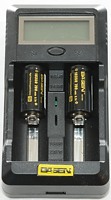
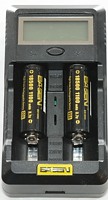
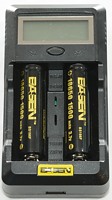
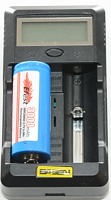
The charger can handle 69 mm long batteries including flat top cells. The specifications also list 10440 batteries, but the current is slightly high for this battery size.
Measurements
- Below 0.5 volt the charger will apply 4mA charge current and display will be off.
- Above 0.5 volt the charger will apply regular charge current.
- Above 2.0 volt charger assumes LiIon battery.
- Voltage readout will freeze when charging is done.
- Charger will not restart if voltage drops.
- Charger always starts with 0.5A charge current and charge function.
- Voltmeter shows about 0.03 volt to high at 0.5A current and LiIon voltages.
- Voltmeter shows about 0.04 volt to high at 1A current and LiIon voltages.
- Voltmeter shows about 0.08 volt to high at 0.5A current and NiMH voltages.
- Voltmeter shows about 0.12 volt to high at 1A current and NiMH voltages.
- Charge will restart charging after power loss, or battery insertion.
- It is possible to change current and mode during charge.
- 2x3 beeps when finished with charging or capacity measurement.
- The alarm is also sounded after the initial charge in capacity measurements
- The background light turns on when a battery is put into the charger or the switch is pressed and turns off again after 30 seconds.
- When not connected to power it will drain about 12mA from the battery.
LiIon charge
%20%231.png)
A very nice CC/CV charge curve with a termination current around 50mA.
The charger reported that it had charger 2549mAh into the battery, that is on the low side.
%20%232.png)
The second channel does also show a fine CC/CV curve and reported 2539mAh.
%20%231.png)
%20%231.png)
Also a nice CC/CV curve and with 2064mAh and 2758mAh the charged capacity is again on the low side.
%20%231.png)
The 0.5A charge is just as fine and uses the same termination current. Here the reported charge is 2402mAh
%20%231.png)
%20%231.png)
My old 16340 IMR cell is also charged fine and the reported capacity more correct (204 & 208mAh).
%20%231.png)
%20%231.png)
The two smaller cells is charged fine.
.png)
Two cells are no problem and is charged at full current.
.png)
The charger uses nearly 1A when charging.

M1: 41,4°C, M2: 40,6°C, M3: 38,9°C, M4: 47,9°C, HS1: 54,0°C
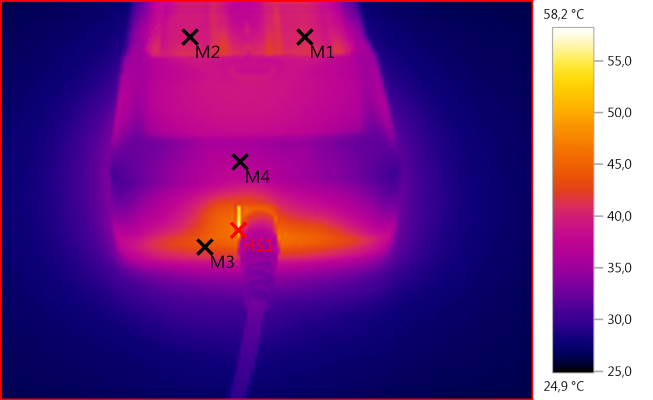
M1: 40,7°C, M2: 39,9°C, M3: 43,5°C, M4: 36,8°C, HS1: 58,2°C
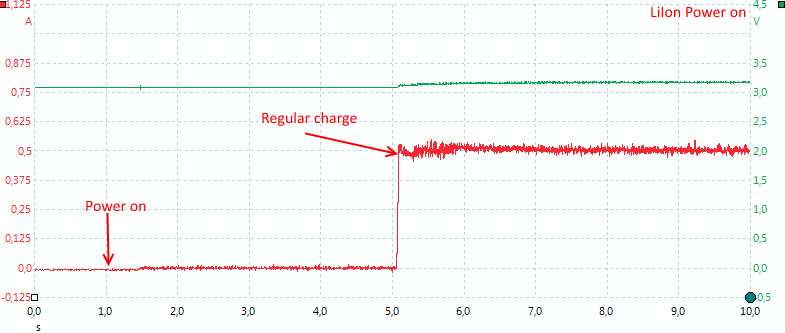
The charger is fairly fast to start for an advanced charger, this is not a problem because it is possible to change settings after it has started.
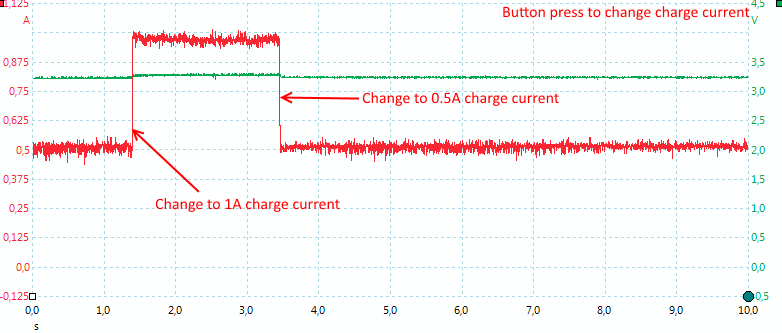
Here I tried to switch between 0.5A and 1A and back again. Selecting capacity measurement will not be visible, because it will only be activated when the battery is full.
LiIon capacity
This function is called "CAP" (Short for capacity), because the charger does not only discharge the battery, it first charges, then discharges and finally charges again.
The display will show the discharged capacity.
%20%231.png)
When a 0.5A charge current is selected the discharge current is 0.25A. The charge, discharge, charge sequence can be seen on the chart. There is no pause between them.
The charger reported 3115mAh in capacity.
%20%231.png)
When a 1A charge current is selected the discharge current is increased to 0.5A.
The charger reported 3174mAh in capacity.
.png)
It is also possible to use 0.5A discharge current with two batteries.
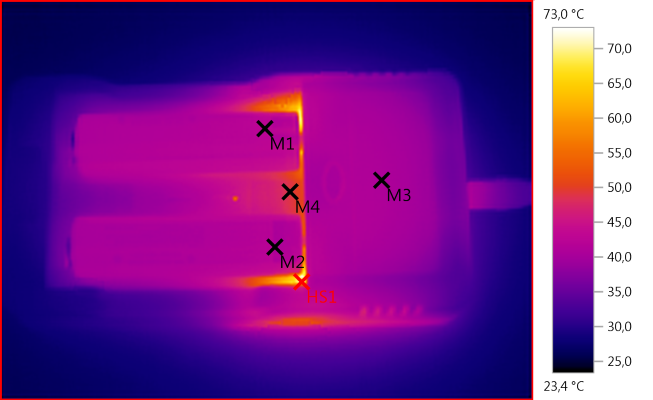
M1: 42,6°C, M2: 40,9°C, M3: 40,8°C, M4: 49,3°C, HS1: 73,0°C
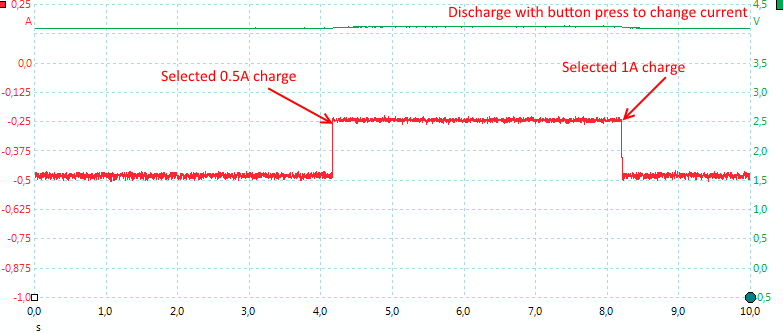
It is possible to change discharge current during discharge.
Both discharge currents are done with a constant current discharge, no pwm.
NiMH charge
%20%231.png)
For NiMH the charger uses a voltage termination and no top-off charge. This means that the batteries are not completely filled.
For this battery the charger reported 1673mAh charged.
%20%232.png)
The second channels works exactly the same way.
%20%231.png)
Using 0.5A charger does not change anything, expect the display now shows it has charged 3288mAh (Oops, this must be a software bug in the charger).
%20%231.png)
The charger reports 1937mAh for this battery.
%20%231.png)
And 2141mAh here.
%20%231.png)
The charger reports 1272mAh charged into the battery, this is not a missed termination but the software bug again.
%20%231.png)
The charger detects a full battery in about 5 minutes.
.png)
No problem with two batteries at a time.
.png)
With external power supply I can see that it needs about 0.5A for charging two NiMH at 1A.
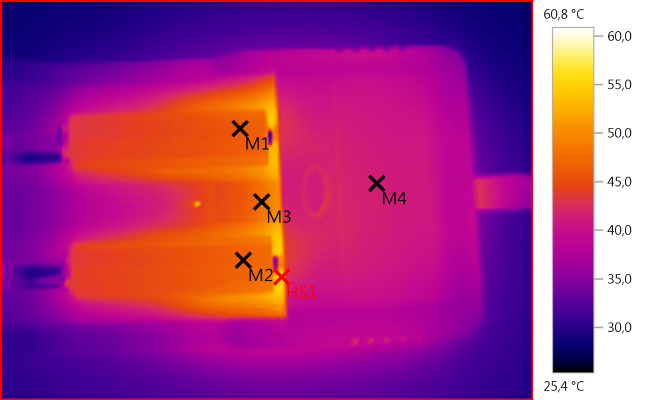
M1: 46,2°C, M2: 46,9°C, M3: 48,1°C, M4: 41,4°C, HS1: 60,8°C

The charger is fairly fast to start for an advanced charger, this is not a problem because it is possible to change settings after it has started.

Here I tried to switch between 0.5A and 1A and back again. The charger does not use pwm to adjust current, but charges directly with selected current. Selecting capacity measurement will not be visible, because it will only be activated when the battery is full.
NiMH capacity
This works the same as for LiIon, i.e. this function is called "CAP" (Short for capacity), because the charger does not only discharge the battery, it first charges, then discharges and finally charges again.
The display will show the discharged capacity.
%20%231.png)
With the 1A charge and 0.5A discharge I got a 1738mAh capacity reading.
%20%232.png)
%20%231.png)
With the 0.5A charge and 0.25A discharge I got a 1786mAh capacity reading.
.png)
With two eneloops and 0.5A discharge current everything gets a bit warmer, but nothing near what happens with LiIon, because the power is much lower.
The display shows 1744mAh and 1807mAh
LiIon & NiMH mixed charge
Here I have tested with one LiIon and one NiMH battery in the charger at the same time and done a measurement on each of them.
.png)
It looks like the eneloop is charged less than usual and the reported charge is 1089mAh for the eneloop and 2517mAH for the LiIon.
.png)
Testing the other way around looks better, here the LiIon was 2502mAh and the eneloop was 1712mAh
USB output
- USB output works from either battery slot or from both.
- USB output is always on when there is a battery in the charger and no power is connected.
- USB output is disabled while charger is connected to power.
- When battery voltage is below 2.8 volt it will only drain 0.7mA from the battery.
- USB output can only deliver above 1A with two batteries.
- USB output is coded as Apple 1A.
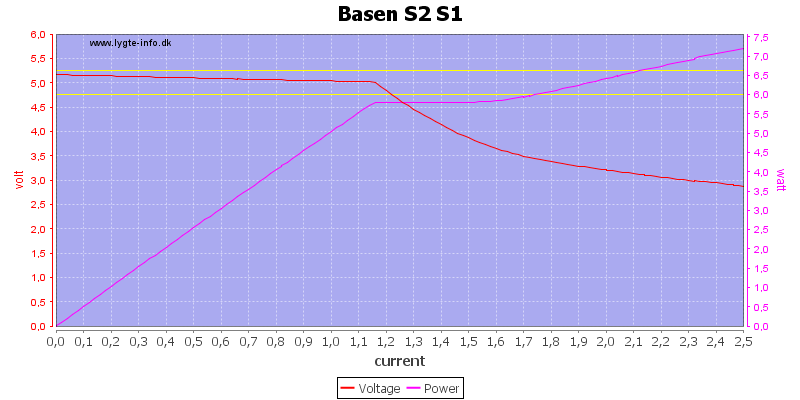
With battery in slot #1 it usb output delivers 1.1A, before it reduces the output voltage.

Slot #2 works the same way.
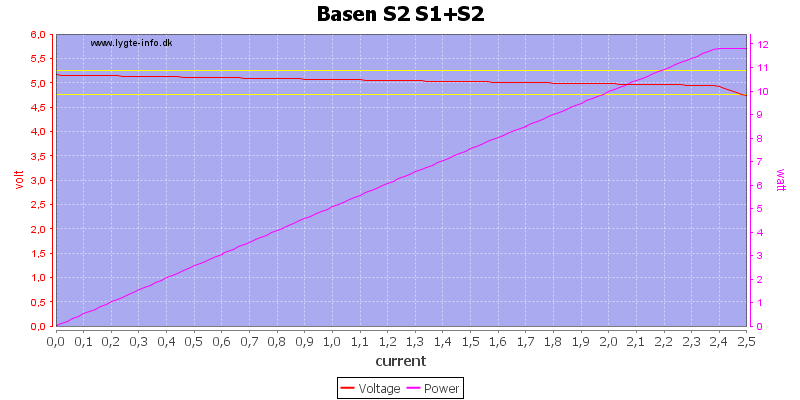
When there is a battery in both slots the current is double up.
%20%231.png)
%20%232.png)
With 0.5A the output voltage is slightly above 5V and very stable. The battery is not disconnected when it is empty, instead the output voltage is lowered and the battery held at 2.8 volt.
%20%231.png)
%20%231.png)
Different sizes means different runtimes.
%20%232.png)
%20%232.png)
Increasing the load to 1A, the box has problems keeping the voltage up when running on one battery.
.png)
With two batteries it works much longer, but the batteries are discharged at different rates and when one battery is empty the voltage drops.
Note: Efficiency calculations are invalid, because I only measure current on one battery.
.png)
Increasing load to 2A with two batteries in the charger works for some time.
Note: Efficiency calculations are invalid, because I only measure current on one battery.

The noise is low, with 0.5A load it is 2mV rms and 60mVpp

With 1A load it is 3mV rms and 70mVpp
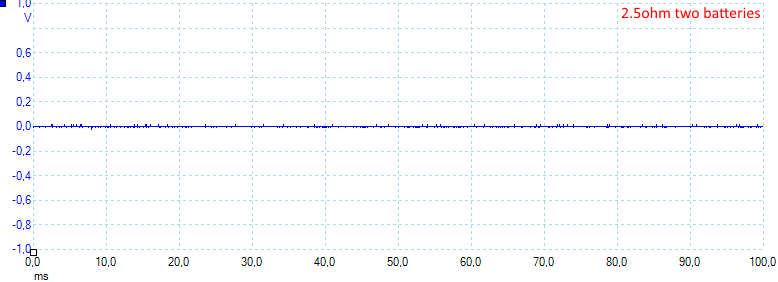
With 2A load it is 3mV rms and 70mVpp
The charger passed a isolation test with 2500 volt, but failed a 5000 volt test, this makes the charger acceptable for 110VAC usage, but doubtful for 230VAC usage. Usage with 12 volt (in a car) is, of course, always possible and safe.
Conclusion
This is simple a analyzing charger. I like the idea behind it, but it could be improved, especial with:
Better precision in the mAh measurement for LiIon.
Better charging of NiMh batteries.
Support for longer batteries.
I can not really complain about the usb output, it delivers 1A as it is coded for.
I do expect they deliver another power supply for Europe.
As the charger is now it is a good LiIon charger, but only useable as NiMH charger. The capacity measurement looks fairly good for NiMH, but not very good for LiIon.
Notes
The charger was supplied by Basen for a review.
Here is an explanation on how I did the above charge curves: How do I test a charger
Read more about how I test USB power supplies and chargers























%20%231.png)
%20%232.png)
%20%231.png)
%20%231.png)
%20%231.png)
%20%231.png)
%20%231.png)
%20%231.png)
%20%231.png)
.png)
.png)




%20%231.png)
%20%231.png)
.png)


%20%231.png)
%20%232.png)
%20%231.png)
%20%231.png)
%20%231.png)
%20%231.png)
%20%231.png)
.png)
.png)



%20%231.png)
%20%232.png)
%20%231.png)
.png)
.png)
.png)



%20%231.png)
%20%232.png)
%20%231.png)
%20%231.png)
%20%232.png)
%20%232.png)
.png)
.png)


